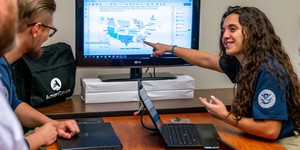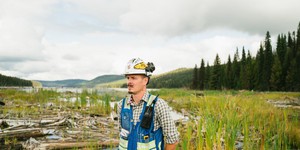Abstract
Have you ever seen news coverage or other pictures of an oil spill in the ocean and wondered how all of that oil could be cleaned up? Oil spills can devastate wildlife by covering them with oil, and they can damage our precious water resources by contaminating them with oil. Part of the problem of dealing with oil spills is that the oil can be challenging to clean up. In this science project, you will test the absorptivity of different materials (called sorbents) to discover which ones are best at removing oil from water.Summary
Kristin Strong, Science Buddies
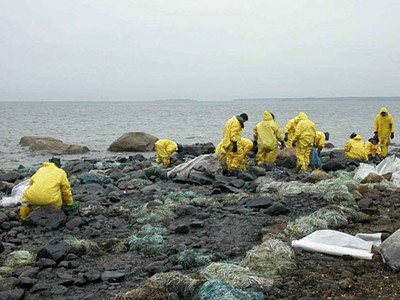
Objective
Compare the absorptivity of different sorbents used for cleaning up an oil spill in water.
Introduction
Stop, look down, and wiggle your toes. Are you wearing shoes? If you are, chances are good that some part of those shoes is made from petroleum oil. Now look at the fabric of your clothes, chair cushion, bedspread, mattress, carpet, and drapes. Many of these fabrics were made from oil. Wander into the kitchen for a glass of milk or soda. The wax in that milk carton and materials in the soda bottle were made from oil. Open up the fridge and look at all the fruits and vegetables-those were grown with the help of fertilizers and pesticides, also oil-containing products. Check out your cupboards. All the packaging you see is made from oil, and the canned goods have additives made from oil, too. Next, head to the bathroom and take a look at all the make-up, medicines, lotions, toothpaste, shampoos, and bandages made from oil. The laundry room also has oil-derived detergents to keep all those oil-made fabrics clean. And even the roof that keeps you dry needs oil to make it waterproof. Seems like everywhere you look around your home, from the ink in your pen to your movie DVDs, you see something that was made from oil.
Oil products are everywhere, including the outdoors: car tires, roads, fuel that powers cars and ships, and heats homes. As you can tell, oil continues to be a very important product in our society, despite climate change fears. Because oil is used in so many ways, great amounts of it are carried long distances to the factories and plants all over the world that use it to make the products that keep our society running. Every day, millions of barrels of oil are moved around, mostly on big ships, called oil tankers. Each tanker can carry more than 200,000 tons of oil.
Occasionally, these tankers have accidents—they hit other ships or scrape against rocks or ice and their hulls break open, spilling oil into the sea. Oil spills can also happen when oil rigs are damaged. The spilled oil can contaminate water resources and devastate wildlife nearby. For an example of what this looks like, see Figure 1, below, which shows workers cleaning up an oil-covered beach after an oil spill.

Figure 1. This picture shows workers cleaning up a beach after an oil spill.
One way environmental engineers try to clean up the oil spills before they kill wildlife and damage habitats is with sorbents — materials that are good at absorbing liquids. If you have ever used a sponge, paper towel, or kitty litter, you have used a sorbent. In this project, you will evaluate the absorptivity of common sorbents, many of which are currently used on a large scale to clean up real oil spills.
Terms and Concepts
- Petroleum oil
- Sorbent
- Absorptivity
Questions
- What characteristics make a good sorbent?
- Is a sorbent enough to clean up an oil spill?
Bibliography
This source provides an overview of petroleum oil uses and oil spills:
- Absorbents Online. (n.d.). Oil Spill Basics. Oil Spill Intelligence Report. Arlington, MA. AbsorbentsOnline. Retrieved March 6, 2008.
This page on the Environmental Protection Agency (EPA) website discusses the properties of oil that affect cleanup:
- EPA. (2008, March 3). Petroleum Oils. Retrieved March 31, 2008.
For help creating graphs, try this website:
- National Center for Education Statistics, (n.d.). Create a Graph. Retrieved June 25, 2020.
Materials and Equipment
- Newspaper
- Large plastic garbage bag
- Liquid measuring cup, 4-cup size; the angled, read-from-the-top types are easiest to use. These types of measuring cups are available at some grocery stores or through online suppliers such as Amazon.com.
- Four or more sorbents that you want to test (3 cups of each)
- Examples include: cotton, hair, fur, straw, coconut husks, corn cobs, corn husks, polypropylene pads, shop towels, and bird feathers. Barber shops or pet groomers are good places to get hair or fur. Shop towels and polypropylene pads can be purchased in the automotive section of many stores.
- Scissors, if sorbent needs to be cut into smaller pieces
- If you are using a coconut husk as one of your sorbents, you will need the following materials:
- Gloves and eye protection
- Hammer
- Large towel or burlap bag
- Paper or glass bowls, 12-oz size (need three bowls for each sorbent you are testing)
- Vegetable oil (1 gallon)
- Pitcher of water
- Dry measuring cup, 1-cup size
- Reusable mesh coffee filter. It should fit easily inside the 4-cup liquid measuring cup; available at stores that sell coffee supplies, such as some grocery stores, or through online suppliers such as Amazon.com.
- Stopwatch, timer, or clock that shows seconds
- Liquid soap
- Lab notebook
- Graph paper
Experimental Procedure
- Spread newspaper onto your work surface, to make cleanup easier.
- Open your garbage bag and put it close to the liquid measuring cup.
- Prepare your sorbents one at a time so you can keep your workspace uncluttered.
- Cut large sorbents into small, thumb-sized pieces so that they can easily fill a measuring cup. Figure 2, below, shows examples of prepared sorbents. Prepare at least three cups of each sorbent you want to test this way.
- Use caution when crushing or smashing coconut husks. Wear eye protection and gloves, and cover the coconut with a large towel or place it in a burlap bag before smashing it. Be sure to only smash the coconut on a surface that you have permission to hammer on.
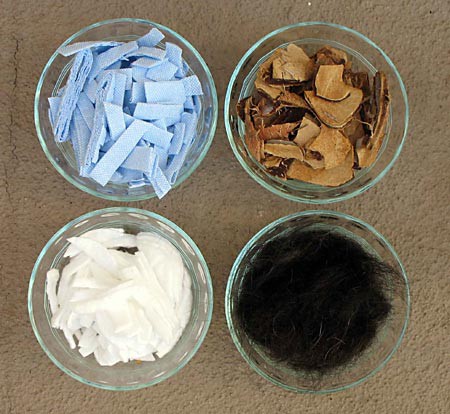 Image Credit: Kristin Strong, Science Buddies / Science Buddies
Image Credit: Kristin Strong, Science Buddies / Science Buddies
Figure 2. Four prepared sorbents (clockwise from top left): shop towels, coconut husk, hair, and cotton.
- After you have prepared your first sorbent, divide it into three piles of 1 cup each and place each pile in a glass or paper bowl.
- In your lab notebook, make a data table, like Table 1, below, for each sorbent to record your results. Be sure to fill in your tables with the actual names of the sorbents you are testing.
| Sorbent 1 Name (for example, Fur) | Total Water and Oil Level (A) |
Remaining Water Level After Removing Sorbent (B) |
Remaining Oil Level After Removing Sorbent (A-B) |
Ratio of Remaining Water Divided by Remaining Oil (B / (A-B)) |
|---|---|---|---|---|
| Trial 1 (using first cup of sorbent) | ||||
| Trial 2 (using second cup of sorbent) | ||||
| Trial 3 (using third cup of sorbent) |
- Pour 3 cups of water into the liquid measuring cup.
- Slowly add 1 cup of vegetable oil. Do the oil and water separate or mix?
- Note: In some trials, a layer of bubbles may form between the water and oil layers. If this happens, wait a few minutes until the bubble layer mostly disappears.
- Put 1 cup of your first sorbent into the reusable mesh coffee filter. Lower it slowly into the water-oil mixture and gently move it from side to side for a few seconds until the sorbent is completely submerged, as shown in Figures 3 and 4. You may need to slowly lower the filter below the surface of the liquid in the measuring cup for liquid to easily get into the filter.
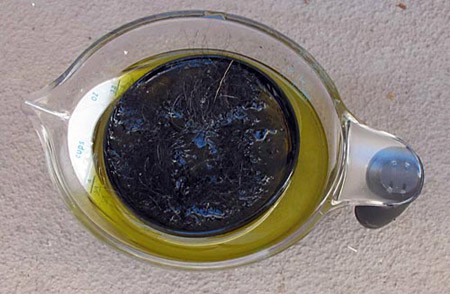 Image Credit: Kristin Strong, Science Buddies / Science Buddies
Image Credit: Kristin Strong, Science Buddies / Science Buddies
Figure 3. Testing hair as a sorbent.
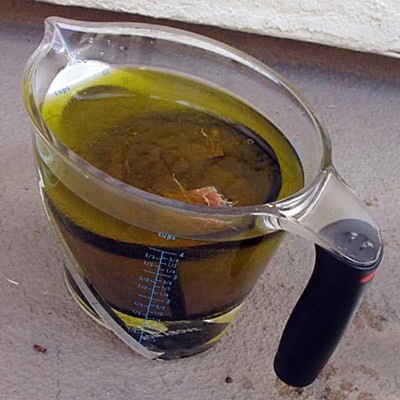 Image Credit: Kristin Strong, Science Buddies / Science Buddies
Image Credit: Kristin Strong, Science Buddies / Science Buddies
Figure 4. Testing coconut husk as a sorbent.
- After the sorbent has been submerged in the liquid, start your stopwatch or timer (or note what time it is on your clock).
- After 30 seconds, lift the filter with the contents of the sorbent inside and hold it just above the surface of the water-oil mixture for 30 more seconds to drain.
- Dump the contents of the mesh coffee filter into the plastic garbage bag.
- Get down level with the liquid measuring cup and read and record the total water and oil level (measure A, as shown in Figure 4).
- Measure and record the remaining water level (measure B, as shown in Figure 4).
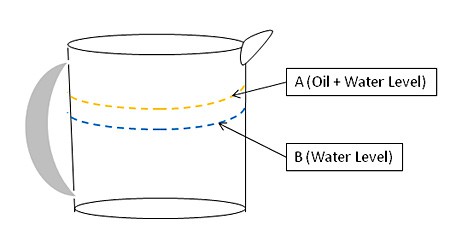 Image Credit: Kristin Strong, Science Buddies / Science Buddies
Image Credit: Kristin Strong, Science Buddies / Science Buddies
Figure 5. Measure point A and point B after removing sorbent.
- Wash out the mesh coffee filter and measuring cup with soap and water.
- Repeat steps 6–14 for the remaining piles of your first sorbent.
- Then repeat step 6–15 for the rest of the sorbents you chose.
- Now calculate the remaining oil after removing the sorbent (by subtracting B from A) for each trial and record it in your data table.
- Calculate the ratio of remaining water to remaining oil for each of the trials and record it in your data table.
- Average the ratios for each sorbent (for the three trials for each sorbent) and record them in a new data table, like Table 2, below.
| Sorbent Name | Average Ratio of Water to Oil |
|---|---|
| No Sorbent | 3 |
| Fur | |
| Hair | |
| Straw | |
| Cotton | |
| Corn Husk | |
| Coconut Husk | |
| Polypropylene Pads |
- Make a bar graph of your results. You can make a graph by hand, or use a computer program like
Create a Graph to make a graph on a computer and then print it out.
- Plot the average water-to-oil ratios (on the y-axis, or the vertical axis) vs. the sorbents you tested (on the horizontal axis, or the x-axis). Make a bar for each sorbent you tested.
- Analyze your results. The higher the ratio, the better the sorbent was at removing oil.
- Are any sorbents less than the starting ratio of 3? This means that the sorbent absorbed more water than oil and would not be a good candidate for cleaning up oil spills.
- Which sorbents have the highest average water-to-oil ratio? These would be the best sorbents for oil out of the different sorbents you tested.
Ask an Expert
Global Connections
The United Nations Sustainable Development Goals (UNSDGs) are a blueprint to achieve a better and more sustainable future for all.
Variations
- This science project let you investigate which sorbent was the best based on the volume of oil and water it absorbed. Which sorbent is the best by mass? Figure out a way to do this by weighing the liquids and sorbents you used (before and after soaking the sorbents in the water and oil mixture), and then give it a try!
- Do some sorbents work faster than others? Investigate which sorbent is the best by time.
- Does shape impact absorptivity? For the same weight, what happens when you twist or roll a sorbent tightly? What if you leave it in big pieces or chop it up? Devise a way to figure this out and then give it a try!
Careers
If you like this project, you might enjoy exploring these related careers:
Related Links
- Science Fair Project Guide
- Other Ideas Like This
- Environmental Engineering Project Ideas
- My Favorites





